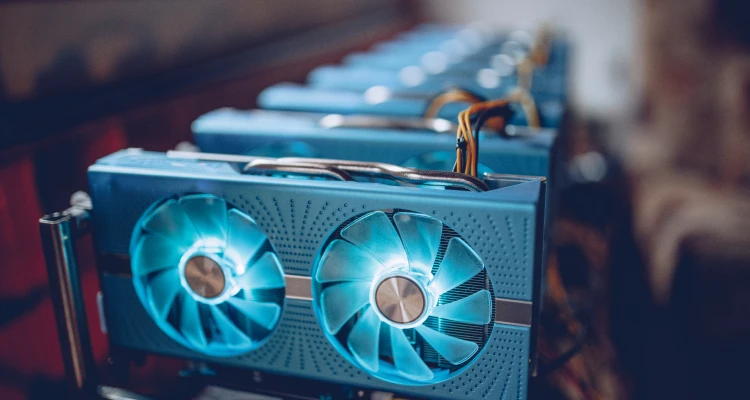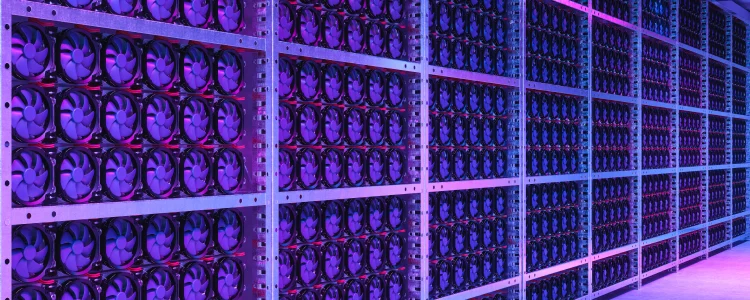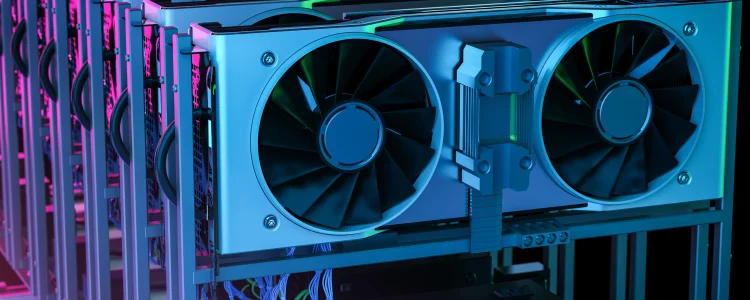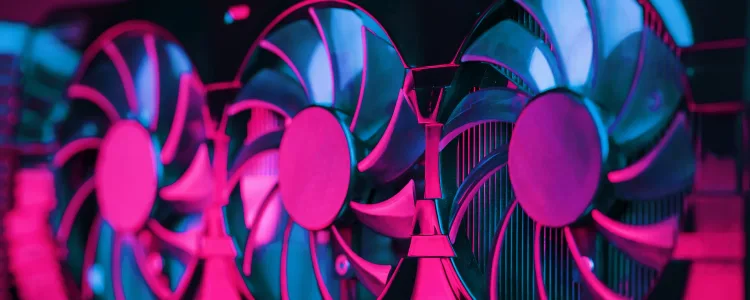What is a GPU Dedicated Server?

Among the various types of servers available today–like shared servers, cloud servers, and CPU dedicated servers–GPU dedicated servers have emerged as a critical part to modern tech. While many gamers know what an NVIDIA GPU is, they’re used for far more than video games.
Unlike your standard CPU dedicated server, which excel at doing difficult tasks one at a time, GPUs are able to take advantage of CUDA cores to perform thousands of tasks all at the same time. This has helped precipitate an explosion of new artificial intelligence technologies and machine learning models, as well as innovations within video transcoding and more.
ServerMania has been a leader in server setup and management for over ten years. We offer a wide range of server options and support, including the latest NVIDIA GPU’s. In this article, we’ll dive into exactly what GPU hosting is, how they work, the advantages (and disadvantages) of GPU dedicated servers, and a comparison to other server types.
What is a GPU Dedicated Server?
For those who are more interested in video games, the term “GPU” is probably familiar to you already.
Your typical Central Processing Unit (CPU) handles the most important parts of how a computer runs–things like the operating system, web browsing, and day-to-day tasks are all controlled by it. They offer excellent processing power, but they’re severely limited by the number of concurrent tasks they can run.
A GPU is similar, with the processing power to accomplish tasks just like a CPU can. However, instead of offering incredible speeds (at the cost of limited concurrency), they can perform thousands of operations all at once, though not at the same speed. They’re most commonly used today for their graphics rendering capabilities within video games but have recently exploded with the surge of artificial intelligence and blockchain technologies.
Read more: A Game Developer’s Guide to Dedicated GPU Servers
For a pretty simple comparison between CPUs and GPUs, check out the Mythbusters’ explanation for NVIDIA.
One of the crucial parts that make up a GPU is its cores, which make up the computing power for GPU performance. They are the primary processing units within the GPU that handles individual tasks. Modern GPUs offer a multi-core architecture, such as NVIDIA’s Pascal chip architecture, opening them up to handle a variety of different workloads. These can be further broken down into different categories:
- CUDA cores are the “general purpose” cores designed to execute a wide variety of tasks in parallel. They are found in NVIDIA GPUs, while AMD has Stream Processors that provide the same function.
- Tensor Cores are specialized processing units inside an NVIDIA GPU that are specially designed for AI processing and deep learning. Tensor core technology makes up a significant part of how machine learning models are trained with deep learning projects.
- RT cores & Ray Accelerators primarily handle complex light calculations for 3D rendering and faster ray tracing, which are mostly used within virtual reality projects and other intense graphics rendering work.
GPU servers offer significant improvements over a standard CPU server configuration due to their high computing power, efficiency in handling large datasets, and speed in AI and deep learning. Their parallel processing capabilities, driven by thousands of cores, make them much faster than CPUs for specific computations such as matrix operations and rendering.

How Do GPU Dedicated Servers Work?
A GPU server is designed for maximizing computing power by utilizing both GPUs and CPUs. While CPUs handle various tasks in a sequence, a dedicated GPU can focus on a much wider range of tasks simultaneously. While the focus of a dedicated GPU server is the GPU, the server configuration still needs to factor in many of the same requirements as a standard dedicated server.
The architecture of a dedicated GPU server typically involves a multi-core CPU working in tandem with one or more dedicated GPU cards. Each of these GPUs contains thousands of smaller CUDA cores designed for high-efficiency parallel processing, significantly speeding up processing time. This allows GPU servers to distribute complex workloads like processing large data sets for deep learning or tasks like mining and transaction validation in blockchains more efficiently than a CPU-only server.
A GPU server aims for different performance metrics than their counterparts as well, such as:
- Floating Point Operations Per Second (FLOPS) – These are a measurement of a computer’s performance when it comes to floating-point calculations. Floating-point calculations are essential for tasks that require a high degree of precision, like scientific simulations, graphics rendering, and machine learning. For GPU servers, high FLOPS show they can perform more calculations in less time through CUDA cores, making it ideal where rapid and accurate computation is essential.
- Memory Bandwidth – This refers to the rate at which data can be read or written to the server’s memory. It’s critical for performance because it determines how quickly the GPU server can access and process data. GPUs typically offer higher memory bandwidth compared to CPUs, allowing for significantly faster transfer rates. It’s particularly important for real-time applications and large data sets, like validating transactions within a blockchain.
- Latency – Latency is the time it takes for a specific operation or data transfer to be completed. In the context of GPU servers, low latency is essential for real-time applications and high-frequency trading, where milliseconds can make a significant difference. For blockchain technology, low latency is crucial in minimizing the delay between transaction initiation and validation, ensuring a smoother and more responsive network.
- Thermal Design Power (TDP) – TDP measures the maximum amount of heat a computer’s cooling system is required to dissipate under normal workload conditions. It’s an important metric because it impacts a GPU server’s stability and longevity. High-performance GPUs generate a lot of heat, and maintaining optimal performance temperatures is crucial to prevent thermal throttling.

Implementing and Managing a GPU Server
Planning, building, implementing, and managing a server can be difficult. While GPU servers mostly have the same components as any other server, there are other factors you should consider when looking to add one to your business.
Picking the Right Hardware – The heart of a GPU server lies in its hardware. Key components to consider are the type and number of GPUs, depending on your specific applications. High-end models from NVIDIA or AMD are popular choices for their performance in complex computational tasks.
Cooling Solutions – GPUs generate significant heat during intensive operations. Opting for advanced cooling options, such as liquid cooling systems, can keep temperatures in check and ensure the longevity of your hardware.
Maintenance and Power Consumption – Regular maintenance is crucial to keep your server running smoothly. This includes timely updates and physical checks. Also, be mindful of the power consumption; GPU servers can be quite power-hungry. Efficient power supply units (PSUs) rated 80 Plus Platinum or higher are advisable for optimizing energy consumption.
Considering Managed Services – For companies focusing on core business operations, leveraging managed GPU server services with businesses like ServerMania can make a significant difference. It offloads the technical demands of server management, allowing professionals to handle maintenance, updates, and troubleshooting on your behalf.
Choosing the right GPU server and maintaining it effectively requires a balance between hardware prowess and practical management strategies. With careful planning and perhaps a bit of expert support, your AI, machine learning, and blockchain initiatives will be powered by a sturdy, reliable computing foundation.

GPU Dedicated Servers Compared to Other Server Types
Each distinct type of server configuration–GPU, cloud, and CPU–share many common pieces, but are all useful in different ways. For this article, we’ll compare them across three categories: performance, cost-effectiveness, and suitability for specific use-cases.
Performance
Dedicated GPU servers are optimized for tasks requiring high performance computing and parallel processing. They feature multiple CUDA cores designed for handling thousands of tasks simultaneously. Their ability to process large amounts of data concurrently results in significant performance improvements over CPU servers.
For cloud servers, their performance is based on the instance type and it’s configuration. They can scale up and down according to demand, offering flexibility and adaptability. However, their performance can be impacted by network latency or if they’re shared servers. Shared servers offer even lower performance because resources like CPU, memory, and storage are shared among multiple users.
CPU-dedicated servers provide high performance for applications requiring intensive computations but not necessarily parallel processing. They offer predictable performance without variability and are ideal for applications requiring consistent, dedicated performance.
Cost effective solution
The upfront and operational cost of GPU servers are higher than other server types, due to their specialized hardware. Dedicated GPU servers are cost-effective for applications that massively benefit from their high performance computing, as their performance gains can offset these costs.
Unlike other options, cloud servers typically offer flexible pricing models, such as pay-as-you-go and reserved instances, making them cost-effective for businesses with variable workloads. They eliminate the need for significant upfront investment in hardware, but their costs can vary dramatically based on the resources used. They’re more economical for businesses with fluctuating demanding tasks but can be costly for consistent high-performance needs.
A CPU server has moderate to high costs, but it is the most cost-effective option for consistent CPU workloads. It’s a good middle option between a GPU server and shared servers and offers a good balance between cost and performance for CPU-focused tasks.
Use Cases
With the distinct advantage of CUDA cores and parallel processing, a GPU server is best suited for high performance computing tasks such as blockchain mining, machine learning, scientific simulations, and video rendering. And with new technologies like the NVIDIA Volta chip, GPU computing is the standard for artificial intelligence computing.
However, for more everyday applications that don’t benefit from GPU performance, cloud servers offer a flexible and scalable solution. Web hosting, SaaS, development and testing environments are all ideal use cases for a cloud server. With their flexible pricing models and the ability to scale up and down as needed, they’re much more suited for a wide range of uses that don’t require high performance.
Finally, CPU servers stand as the best option for applications that require significant CPU power without GPU instances. Tasks like database management, enterprise applications, high-traffic web servers, and intensive computational tasks are all better suited to a CPU server. The lack of CUDA cores here is generally offset by the better computing resources for single-threaded tasks.
Maximizing Computing Resources With a GPU Dedicated Server
The explosion of AI acceleration through CUDA cores and GPU hosting has made a significant impact on the world. Beyond just blockchain technology, GPU dedicated servers powered by an NVIDIA GPU are helping usher in a massive wave of AI advancements. Plus, these GPU servers can handle massive workloads concurrently, leading to a wealth of new applications as the technology grows.
Are you looking to expand your business or take advantage of GPU hosting? ServerMania has got you covered. With a wealth of experience and a wide range of dedicated servers and cloud hosting, our team can get you running in no time. Book a free consultation with an Account Manager today!
Was this page helpful?

